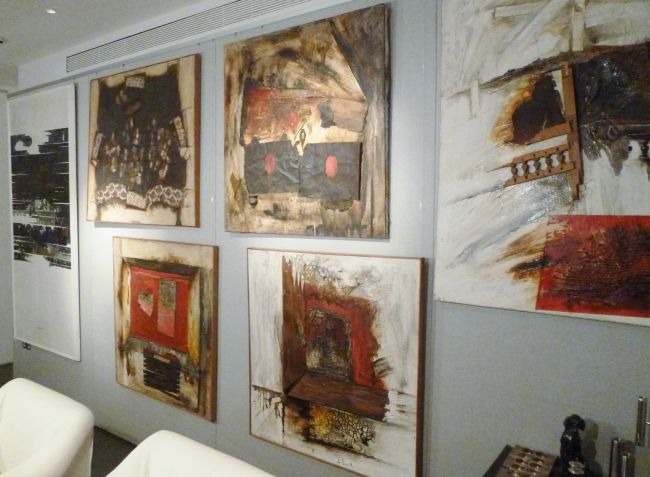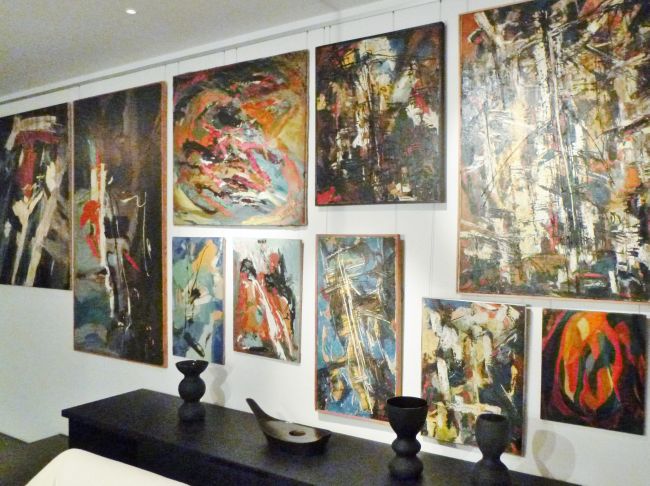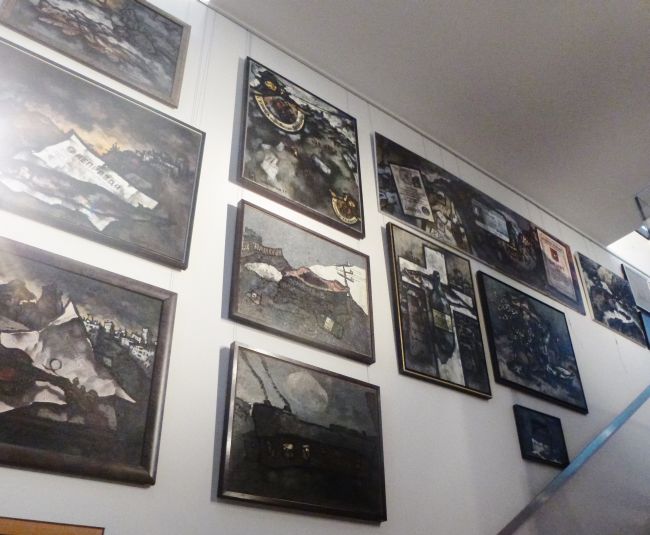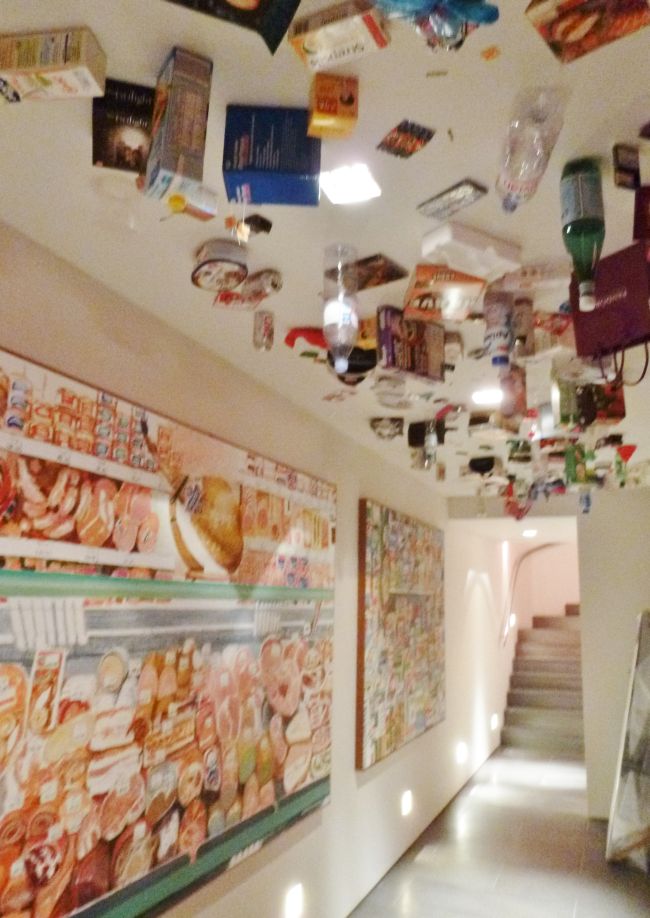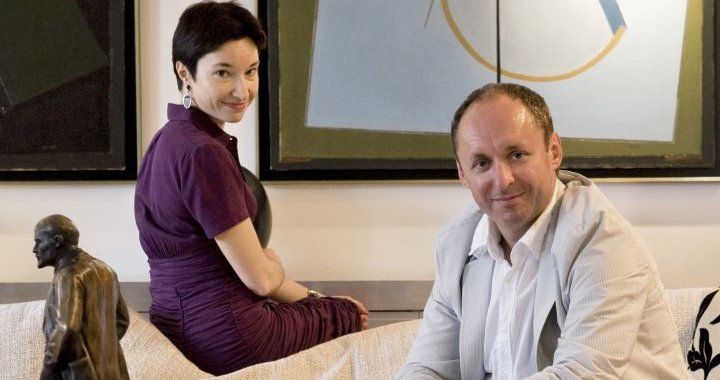
Igor Tsukanov: Russia’s Non-Conformist Art Collector
Simon Hewitt
21/01/2014
Igor Tsukanov is one of the world’s leading collectors of post-war Russian art. His collection now runs to some 350 works by almost 50 artists.
His love of art dates from his Moscow childhood and youthful visits to the Tretyakov Gallery. The first painting he remembers was Viktor Vasnetsov’s Ivan Tsarevich on the Grey Wolf (1889), which he saw when he was just 4.
His first professional involvement with art came via the Tretyakov, too – in 1996, when he was 34. He and his wife Natasha (they met as students in the late 1980s, at Moscow’s Institute of World Economy & International Relations) were asked to help establish the Gallery’s international fund-raising programme. Some of the firms and businessmen they enticed, like Vladimir Bogdanov and Surgutneftegas, remain sponsors of the Gallery to this day.
Works by Dmitry Plavinsky
The first work they helped acquire was by Mikhail Vrubel, but Igor soon realized there was little point in increasing the museum’s sizable holdings of early 20th Russian art, and helped steer acquisitions towards such post-war artists as Pivovarov, Plavinsky, Nezvestny and Francisco-Infante.
Igor himself, however, only began buying paintings in 2000, after encouragement from Anatoly Bekkerman, a charismatic New York dealer who had moved from Russia to the United States in the 1970s.
‘I started buying slowly’ recalls Igor – mainly Russian artists from the first third of 20th century like Goncharova, Roerich, Exter, Anisfeld, Grigoriev and Yakovlev. He has since sold most of these works, though retains paintings by Exter and Anisfeld – whose Garden of the Hesperides (from 1916) is now the oldest work in his collection.
But he soon decided to focus on a tighter-knit theme. This engineer’s son opted to take a scientific approach to collecting, ‘like managing a project, with three major considerations: defining a goal; methodology; resources.’

Marc Quinn’s Sava’s eye
The goal he assigned himself was to build up a top-quality collection of Post-War Russian Art. One motivating factor: there were no major collections of Art from the 1960s-80s in Russian museums, even though it was ‘a unique period within the special social environment of the Soviet Union.’ His method involved exploiting a nascent market in New York, Paris and especially London – fuelled by works taken out of Russia from the 1960s onwards, mainly by journalists and diplomats. As for resources: it had to be a field his family could afford.
He began buying, mainly at auction, in 2004. His collecting coincided with the rise of MacDougall’s auction house, dedicated to Russian Art. Managing Director William MacDougall calls Igor ‘one of the most important Russian art collectors of his generation. You cannot undervalue his work in promoting Russian post-war and contemporary art!’
Works by Evgeny Rukhin
One of Igor’s great pleasures is meeting the artists whose works he buys. ‘They give me insight, and they understand what I want to do.’ As well they might: Igor wants to acquire nothing less than ‘the best two or three pictures’ by each of them, and has no hesitation in paying world record prices like £168,500 for Oskar Rabin’s 1969 Violin at the Cemetery at MacDougall’s in 2006, or £468,500 for Oleg Vasiliev’s 1990 Before the Sunset at Sotheby’s in 2008. He has also set record highs to secure works by Oleg Tselkov and Evgeny Rukhin, but has ‘no regrets,’ adding: ‘In my view, Russian artists of this period are as yet not overpriced.’
He is also prepared to be patient. He spent five years waiting to acquire Tselkov’s important early work Man with Flower, regularly asking its owner once a year – via a Paris gallery – if he wished to sell. In 2012 the collector finally agreed. It may have helped that Igor ‘always pays the best price.’
Although Igor’s collection will undoubtedly prove an astute investment, it is not locked up in a bank vault but plentifully displayed around the family’s homes in London, Moscow and the south of France. Their house in Kensington was acquired in 2007 (the year Igor sold his Centr-Invest Group) for this very purpose. ‘White walls, wood, metal – that’s all we need’ was his brief to architect Seth Stein. ‘All the colour will come from the paintings!’
Faibisovich - Tsoy's Wall
There’s a Rabin staircase, a Sots Art staircase, a Faibisovich wall, Abstract walls (devoted to Plavinsky, Rukhin and early Masterkova), and a basement roomful of works by Alexei Kallima – two market-store still lifes and a Spoerri-like, 3-D ceiling-installation – which Igor snapped up from Regina Gallery in London in 2012. The main staircase is lined with a dozen Rabins, flanked by four Krasnopevtsevs at the top and four Tselkovs – each from a different period, and including the elusive Flower Man – at the bottom.
The main lounge features exceptional works by the under-rated Dmitry Plavinsky, an artist Igor particularly admires. The staircase down to the basement showcases Sots Art works by Brushkin, Kosolapov and Komar & Melamid, and the downstairs lounge has a Faibisovich wall opposite a kitchen arrayed with neo-Suprematist porcelain plates by Vladimir Nemukhin.
.jpg)
Works by Oleg Tselkov
The walls of his Moscow apartment feature works by Belenok, Ovchinnikov, Schwartzman, Neizvestny, Pivovarov, Annenkov, three early Vasilievs and Tselkov’s purple-hued Five Faces – the work reproduced on the cover of the catalogue to the Breaking The Ice exhibition held at London’s Saatchi Gallery in the winter of 2012/13.
Igor was the principal contributor to this landmark exhibition, lending nearly half the works; the rest came from international private and public collections, including the world’s most famous repository of Russian Non-Conformist Art: the Zimmerli Museum in New Jersey, home to the Norton Dodge Collection. (Igor had hoped the Zimmerli would lend 25 works but, in the end, they sent six.)
Igor himself would have liked to include ‘more Roginsky’ alongside the intriguing selection of his early Conceptualist works; personally I wished there had been room for works by Alexei Sundukov, Sergei Shutov and Sergei Shablavin.
Works by Vladimir Nemukhin
Igor teamed up with Andrei Erofeyev, former curator of Contemporary Art at the Tretyakov, to ‘structure the exhibition around seven aesthetic themes’ – ranging from the self-evident (Abstract Art or Moscow Conceptual Art) to the contrived (‘Retro Modern Art’). On the whole, reports Igor with some relief, such categorization met artists’ approval. ‘When I asked Nemukhin How do you define yourself?, he answered “I’m an Abstract artist.” So we didn’t make a mistake!’
This scientific approach to classifying works extends to how Igor hangs them at home, hence his penchant for walls devoted to one or two artists, with their works displayed en masse. There is no desire to mix styles. It is a rational, but somewhat predictable, approach that leaves one occasionally yearning for juxtapositions that reflect the collector's personal eye, or provide the opportunity to confront works of differing styles painted in the same year. Such disregard for chronology was/is also to be found at the Saatchi exhibition and the hanging of the Norton Dodge Collection at the Zimmerli.
One of the most powerful works in Breaking The Ice, Oleg Tselkov’s Last Supper, was not from Igor’s collection but is still owned by the artist himself. I wrote in The Huffington Post that it ranks alongside Picasso’s Guernica as ‘the most powerful group image of the 20th century’ and should be bought for the British Nation and hung in Tate Modern. Coincidentally or not, this work was the subject of a presentation to the Tate’s Acquisitions Committee for Russian & Eastern Europe, hosted by Igor in his Moscow flat in September 2013.
Works by Oskar Rabin
Media coverage of Breaking The Ice focused above all on Tselkov, Rabin and the ‘mischievous humour’ and ‘baroque kitsch’ of Sots Art, while also remarking on the ‘lack of interest in Russian contemporary art’ among London-based Russian buyers – a phenomenon Igor helps explain as follows: ‘Contemporary art is supposed to be supported by young professionals in their mid-30s but, when it comes to Russians, such people don’t even know where they will be living. They just want to get their children into English schools – they are in no mood to collect.’
With typical modesty, Igor attributed the popularity of Breaking The Ice – which attracted visitors to the Saatchi in unprecedented numbers – ‘only partly to its quality: the venue was very important… the Saatchi has such a reputation!’
He enjoyed working with the Saatchi so much that, this Autumn, he signed a 5-year agreement to prolong the collaboration between the Saatchi Gallery and the Tsukanov Family Foundation through the staging of annual themed exhibitions showcasing Russian art within an international context (an International Pop Art show is planned for Autumn 2014), as well as solo-country shows devoted to contemporary art from former members of the Soviet bloc such as Ukraine, Georgia and Azerbaijan. Kazakhstan is slated to inaugurate this cycle in Spring 2014, with a show co-organized by Moscow dealer/curator Marat Gelman, drawing inspiration from his Face of the Bride show of Kazak artists staged in Perm in 2012.
Igor sees his future rôle as extending beyond just lending works from his collection, and dubs himself an exhibition Producer – responsible for arranging financing, media coverage and curatorial brainstorming. ‘I work on a Hollywood model’ he grins.
Turning that movie-maker metaphor into reality, he is currently filming the interviews he is conducting with all the artists featured in Breaking The Ice, plus some – like Faibisovich, Yankilevsky or Schwarzman and photographer Igor Palmin – who were not in that show. Each artist is asked two set questions, and two varied ones. The resultant, individual 20-minute videos will be posted on MoscowArt.net.
Non-Conformist giant Semyon Faibisovich was oddly reluctant to take part in the Saatchi show – a decision he has since come to regret. During the recent Russian Auction Week in London, Faibisovich was a guest speaker at Igor’s home, offering connoisseurs an exclusive insight into his artistic approach. Igor promptly added Faibisovich’s Tsoy’s Alive! to the four works by the artist already in his collection.
Tsoy’s Alive! is based on a photo of the ‘Tsoy Wall’ in Moscow (commemorating legendary rock star Viktor Tsoy) that Faibisovich took with his mobile-phone in 2006. He only turned it into a painting in 2012, during the government crackdown on civic protests, explaining that: ‘The cult wall, with its brutal anti-Putin attack by Tsoy fans, now became a symbol of people’s freedom and fearlessness in the face of arbitrary rule.’ The message Putin is a Faggot took on added resonance when the State Duma passed a tough anti-Gay law shortly afterwards.
Gorokhovsky - Red Files
Igor Tsukakov continues to expand his Non-Conformist collection – he paid £45,000 for Edward Gorokohvsky’s Red Files at Sotheby’s on 25 November 2013 – but says he won’t carry on for ever, and that ‘a new theme, a new collection’ – is likely to interest him in a few years’ time.
His collection is already expanding to include young Russian artists such as Alexei Kallima and Oleg Dou, and he predicts that ‘several new names will also appear very shortly – artists who have only been active in the past ten to fifteen years – covering not just painting but also other forms of artist expression.’
Works by Alexei Kallima
Igor has also branched, tentatively, into non-Russian art. He owns a Damien Hirst and, in 2012, commissioned Sava’s Eye from Marc Quinn to mark the birth of his son Sava (named after the great early 20th century Russian art collector Savva Mamontov). Quinn’s canvas merges a photograph of Sava’s eye (at the age of 4 months) with a view of the globe. Unlike other works in Quinn’s Eye of History series, however, the centre of the pupil is not the Atlantic Ocean, the North Pole or the Bering Strait, but the Bosphorus: the symbolic crossover of Europe/Asia and the Christian/Moslem worlds.
‘With you-tube and the i-Pad, the world is completely integrated nowadays’ comments Igor. ‘National art is no longer relevant.’

